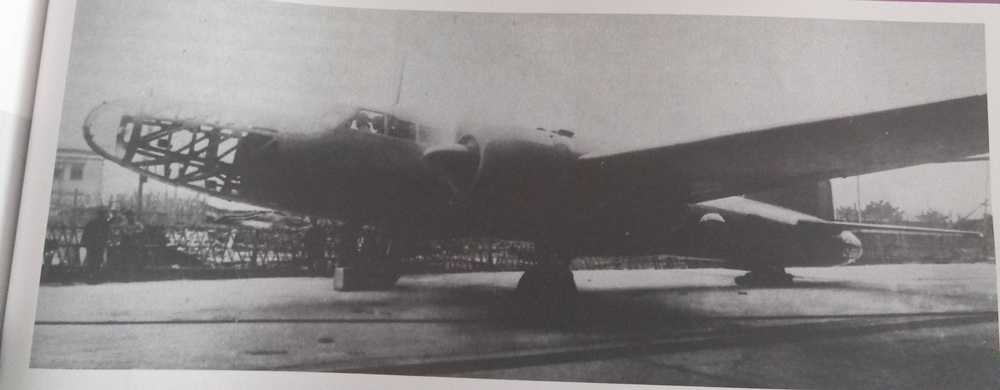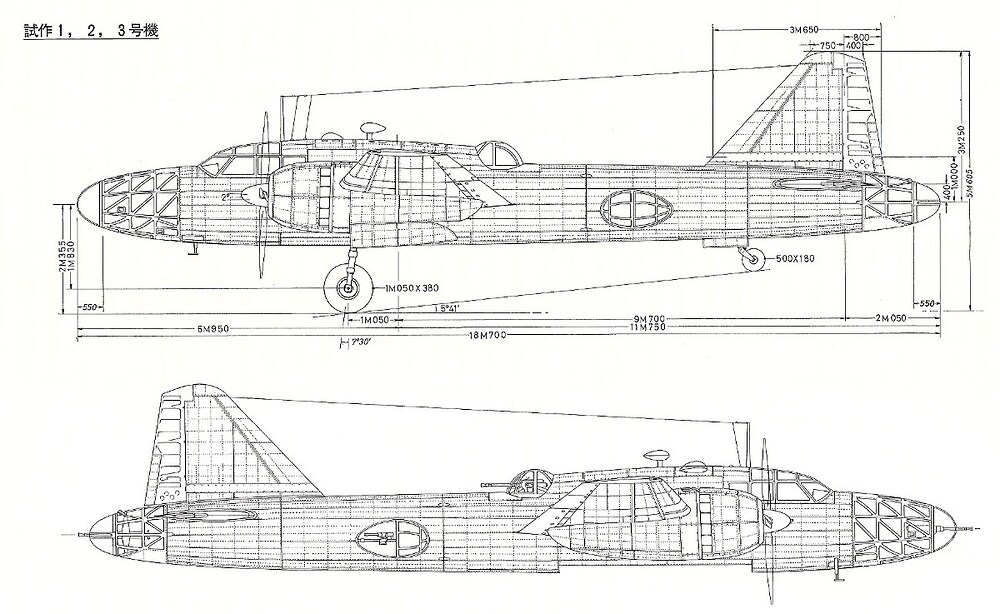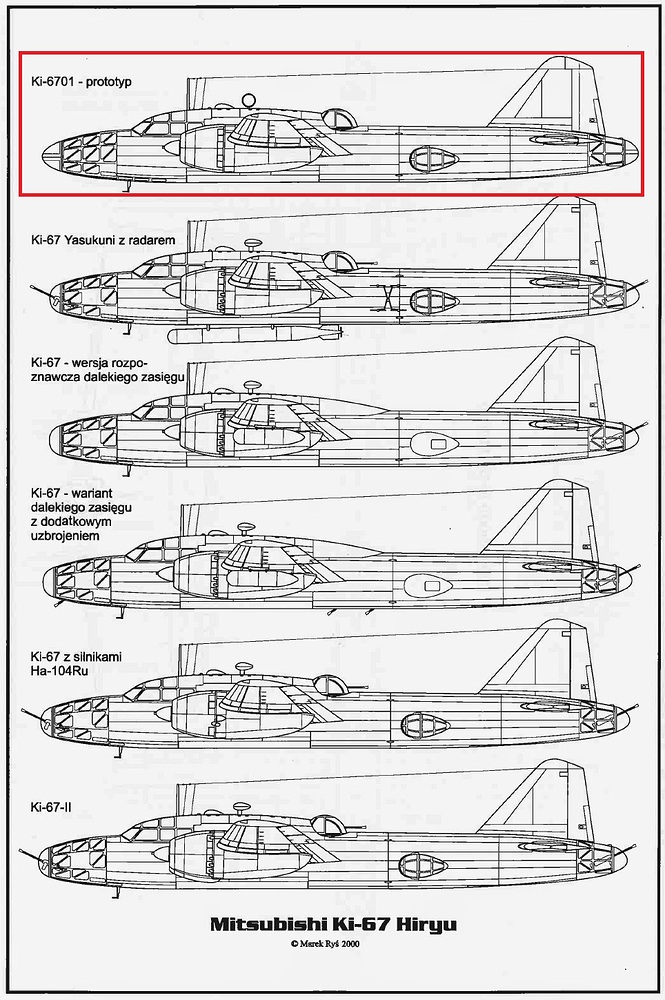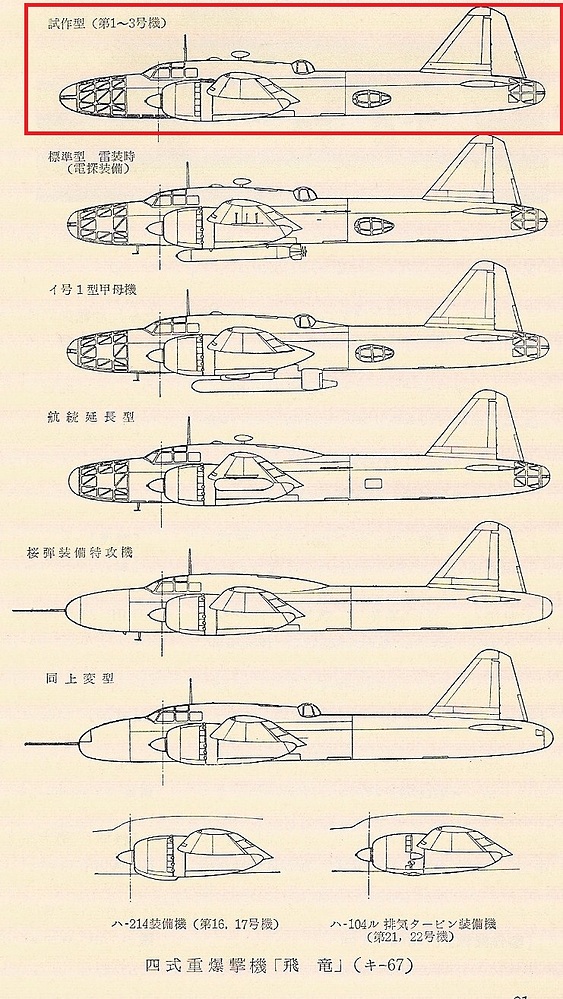- Yes
- No
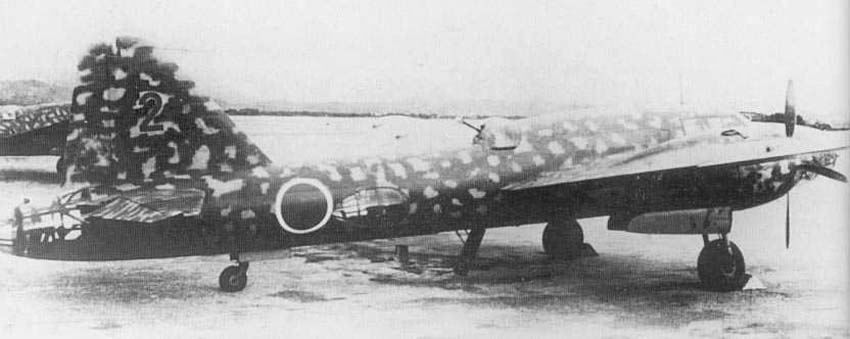
Mitsubishi Ki-67 Prototype (三菱 キ67 プロトタイプ
The Mitsubishi Ki-67 Prototype is a prototype of the Mitsubishi Ki-67 aircraft. This suggestion focuses on the first three prototypes of the Mitsubishi Ki-67 aircraft. The first Ki-67 prototype was completed in early November 1942, and it first flew on December 27, 1942.
History
In 1939, the Japanese army noticed that Chinese and Soviet (the Battle of Khalkhin Gol) Tupolev SB fast bombers were very effective at attacking Japanese positions due to their high cruising speed, which made it difficult to intercept these aircraft. The Japanese army command was also aware that the Ki-21 bombers were becoming outdated, and their successor, the Nakajima Ki-49 (prototyping tests for the Ki-49 began in September 1939), was not an ideal replacement for them. Therefore, in June 1939, the Army Aviation Technology Research Institute began discussions with Mitsubishi and Nakajima on the specifications for a new heavy fast bomber for the army. In December 1939, the Research Institute began receiving reports from Europe indicating that classic fast bombers were suffering heavy losses when intercepted due to their weak armament (for example, the German Dornier Do 17 or Junkers Ju 88). On June 28, 1940, the Army Command ordered a new heavy bomber for the Army from Mitsubishi (Ki-67) and Nakajima (Ki-68)(The Nakajima Ki-68 was actually a modified aircraft of the Nakajima G5N). Then, in September 1940, the technical requirements for the new aircraft were presented. They were as follows:
- Maximum speed 550 km/h
- Operational ceiling 4000-7000 m
- Combat radius with a 500 kg bomb - 700 km, and maximum range without bombs - 1500 km
- Standard lift capacity of 500 kg and maximum of 750 kg (in June 1942, the requirements for maximum lift capacity were increased to 800 kg, but the Ki-67 prototypes did not receive a higher payload)
- Crew of 6 to 8 people and in the escort version 9-10 people (the escort plane Ki-69 was never created)
- The defensive armament was to consist of three Type 98 7.98mm machine guns and two Ho-103 12.7mm machine guns.
- It is recommended to install modern Mitsubishi Ha-101 engines with a power of 1500 hp, Nakajima Ha-103 engines with a power of 1870 hp, or possibly Mitsubishi Ha-104 engines with a power of 1900 hp.
- It was required that three prototypes be created, with the deadline for the first prototype being August 1941.
Mitsubishi factories dedicated a lot of effort to the new aircraft project due to their previous failure against Nakajima (Mitsubishi Ki-50 lost to Nakajima Ki-49). The experienced engineer Kynuoju Ozawa was responsible for the project, and he also chose experienced engineers Teruo Tojo and Yoshio Tsubota as his assistants. Despite the fierce competition between the Japanese Army and Navy at Mitsubishi factories, there was a flow of information, and Ozawa had the support of engineers who had designed the Mitsubishi G4M aircraft. Ozawa decided that the future Ki-67 would be powered by Mitsubishi Ha-104 engines, which were currently in the prototype stage, as the Ha-101 engines were too weak, and the Ha-103 engines were being produced in competing factories. It was also decided to use the pioneering assembly method in Japan of assembling the aircraft from ready-made components, which was supposed to facilitate and shorten production. Ozawa decided to position the main fuel tanks in the fuselage of the aircraft and install a self-sealing system in them. The tanks in the wings did not have self-sealing liners installed. This was a deliberate measure, as the wing tanks were to be consumed first during flight, and also because they were to be dismantled during short combat flights. The defensive armament consisted of three Type 98 7,98mm machine guns in the nose and in side gunner positions, as well as two Ho-103 12.7mm machine guns in the circular turret on the back and in the tail position. In January 1942, the Japanese Army Command approved the Ki-67 project and ordered Mitsubishi to begin its construction, although the technical documentation was only 80% complete. At the same time, the project of the competing Nakajima Ki-68 was transferred from Nakajima to Kawasaki and received the designation Ki-85. Mitsubishi factories were betting that the Ki-67 prototype should be ready by the specified deadline, but there were delays with the Mitsubishi Ha-104 engines and new requirements from the Army emerged, requiring the aircraft to withstand dive attacks. This led to delays, and the first Ki-67 prototype, designated Ki-6701, was completed only in November 1942. The prototype was then sent to Kagamigahara Airfield in Gifu Prefecture. There, on December 17, experienced Mitsubishi pilots Oda and Yamaguchi took the controls, and the aircraft flew for the first time. In February 1943, the second Ki-67 prototype (Ki-6702) was delivered, and in April 1943, the third Ki-67 prototype (Ki-6703). The aircraft quickly impressed test pilots and the Japanese army command with its excellent performance. However, the aircraft did not achieve the required maximum speed, reaching 537 km/h instead of the required 550 km/h. Although the prototypes of the Mitsubishi Ki-67 were very good, they had a few shortcomings, such as the landing gear doors not closing properly or the controls being too heavy. The issue with the controls was resolved by reducing the control surface chord by 20%. The Ki-67 prototypes were further tested (the second prototype crashed due to engine problems), and on February 6, 1943, an order was placed for a series of 17 pre-production Ki-67 aircraft to address the issues of the first three prototypes. In May 1943, the first of the 17 pre-production Ki-67s was delivered, and testing on the prototype aircraft was completed. At the same time, work on the Kawasaki Ki-85 was halted because that aircraft would not be suitable for service. It is not precisely known what happened next to the prototype Ki-67s (Ki-6701 and Ki-6703), but they were likely upgraded to the standard of the production Ki-67s and participated in combat.
Construction description
The Mitsubishi Ki-67 prototype is similar to the production Ki-67, but there are important differences between them that I will try to describe here.
- The airplane has a different shape of the nose glazing and the tail turret.
- There is no armor on the hull.
- The fuel tanks in the wings do not have a self-sealing layer.
- In the hull, the fuel tanks have a capacity of 2566L instead of 3886L.
- Type 98 7,98 mm machine guns are installed in the nose and side turrets.
- A Ho-103 12.7mm machine gun is installed in the dorsal turret.
- The maximum load is 750 kg (3 x 250 kg, 15 x 50 kg) and the regular load is 500 kg.
General characteristics
- Crew: 6-8
- Length: 18,7 m
- Wingspan: 22,50 m
- Height: 8,30 m (?)
- Wing area: 65.0 m2
- Empty weight: 8 649 kg (?)
- Gross weight: ?
- Powerplant: 2 x Mitsubishi Ha-104 (Ha-42-11) air-cooled, twin-star, eighteen-cylinder engine with a take-off power of 1,397 kW (1,900 HP)
- Propellers: Adjustable four-blade metal propeller with a constant rotational speed and a diameter of 3,600 mm.
Performance
- Maximum speed: 537 km/h
- Cruising speed: 400 km/h (?)
- Range: ?
- Maximum Range: 3 800 km (?)
- Service ceiling: 9470 m
- Climb Rate: ?
- Rate of climb: ?
Armament
- Guns:
- 1 x Type 98 7,98 mm machine gun in the nose
- 2 x Type 98 7,98 mm machine gun in side positions
- 1 x Ho-103 12.7mm machine gun in the tail (600 rounds)
- 1 x Ho-103 12.7 mm machine gun in the dorsal turret
- Bombs
- 1 x 500 kg bombs (in the bomb bay)
- 2 x 250 kg bombs (in the bomb bay)
- 3 x 250 kg bombs (in the bomb bay)
- 5 x 100 kg bombs (in the bomb bay)
- 8 x 100 kg bombs (in the bomb bay) (?)
- 15 x 50 kg bombs (in the bomb bay)
- 15 x 30 kg bombs (in the bomb bay)
Armour
- Self-sealing fuel tanks in the fuselage, covered with 16 mm rubber,
Special thanks
Summary
The Mitsubishi Ki-67 prototype is an interesting aircraft for Japan in War Thunder. This aircraft would be a Ki-67 with a lower Battle Rating in exchange for a worse bomb load and weaker bomb armament. Despite the use of inferior defensive armament, this aircraft would still be a dangerous opponent in the sky. I encourage you to discuss in the comments and to share your own knowledge on this subject.
Finally, I apologize for the linguistic and logical errors because unfortunately English is not my main language and I had to use google translator.
Internet sources
四式重爆撃機 - Wikipedia
Mitsubishi Ki-67 - Wikipedia
Mitsubishi Ki-67 Hiryu (Flying Dragon) ‘Peggy’
Mitsubishi Ki-67 Hiryu / PEGGY - bomber
Warplanes of Japan: Mitsubishi Ki-67 Hiryu
Mitsubishi Ki-67 Hiryu (Peggy): zdjęcia, historia, specyfikacja
【キ67】四式重爆撃機『飛龍』/三菱Mitsubishi Ki-67 | 大日本帝国軍 主要兵器
Micubiši Ki 67 Hirjú [Peggy] : Micubiši
Уголок неба ¦ Mitsubishi Ki-67 Hiryu
Japanese Aircraft of WWII: Mitsubishi Ki 67 Peggy Redux
Book sources
- Mitsubishi Ki67 - Ki109 Hiryu in Japanese Army Air Force Service - PDF Room | PDF
- Japanese Aircraft of the Pacific War page 186-191
- Technika wojskowa historia 5/2022 (Military Technology: History 5/2022) page 70-71
- Lotnictwo wojskowe 3/2000 (Military Aviation 3/2000) page 23-25
Additional sources
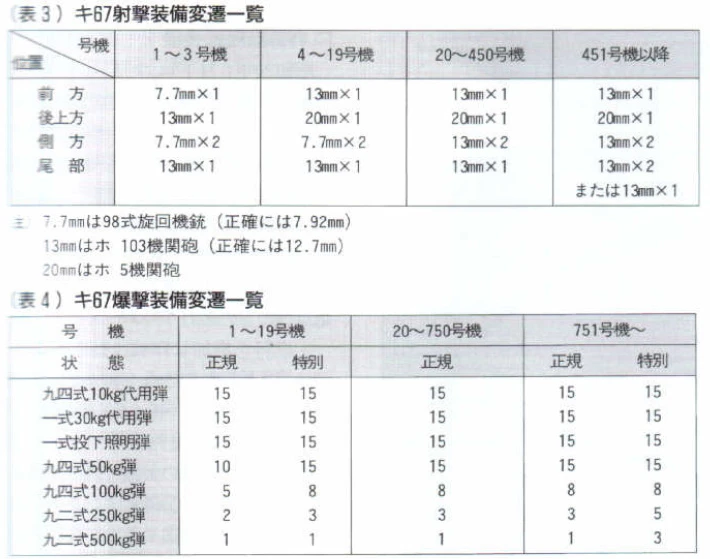

Thank you for reading the suggestion, see you in the next one. Good luck pilots

